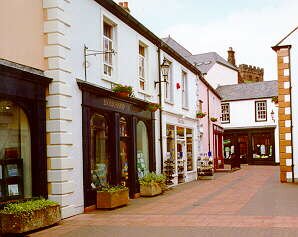Index
page 2
Penrith

|
Towns Index |
page 2 |
||
|
|||
 |
|||
|
|||
|
|
Like many of the towns in the Eden Valley Penrith is built largely with the red sandstone which gives these towns their uniquely warm appearance. One of the best examples is the church of St Andrews, a fine building of 1720-22, in a picturesque precinct. Beside the north wall of the church is the 'Giants Grave', said to contain the remains of Owain king of Cumbria from 920-937.
Penrith dates back to 500BC at which time it would have been a Celtic settlement. Around the C9 and C10 Cumbria was part of the Scottish kingdom of Strathclyde, and Penrith was its capital. It is easy to see why it should have been chosen as such, for it occupies a prime site for communications with the rest of the county, and sits amongst some of the best farming land in the whole country due to its kind climate. The Pennines to the east and the Lake District fells to the west form a natural funnel for traffic coming from either north or south, making the site strategically important. Principally, however, Penrith's function as a market town has left its mark on the town over the centuries: there are no less than five sites within the town with a history of market trading. The success Penrith enjoyed did not go unnoticed by the Scots. The town became a target for raids. The castle that stands over the town was built in 1397 on the site of an earlier building of the 1090's. Later, before becoming King Richard III the Duke of Gloucester was Warden of the border with Scotland and lived in Penrith at what is now the Gloucester Arms pub (known in his time as Dockray Hall) and also at the Two Lions pub. The present buildings on these sites are later than Richard's time, dating from 1580-85 after the last England - Scotland "official" war, though private raiding continued long after that. To the east of the town is Beacon Hill, taking its name from its use as such possibly since Roman times. The present edifice was built in 1719 to warn Penrith and much of the Eden Valley of any trouble. It was last used during the Napoleonic Wars in 1805. Penrith was occupied by Oliver Cromwell's Roundheads in 1654. In 1745 during the Jacobite Rebellion Bonny Prince Charlie passed through on his way to claim the British throne. During his retreat northwards a month later his rearguard fought a battle at Eamont Bridge on the southern outskirts of Penrith. Despite this, Penrith has not suffered greatly from war and rebellion, certainly not as much as Carlisle. By far the biggest killer in the town's history was the plague of 1598, which claimed some 2000 lives.
Richar III Society Homepage |
|
Main Index |
Next Town |
Copyright © EDGE 1997